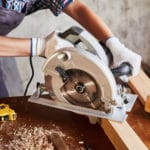It is important for the chain to be tight enough that it doesn’t come off when you are cutting, but not too tight. If the chain comes off while you are cutting then your saw will stop and can cause injury or damage to property.
Use this guide of how tight should the chain be on a chainsaw to get started.
How to Tighten a Chainsaw
When you tighten the chain on your chainsaw, make sure that it is snug enough that it doesn’t come off while you are cutting, but not too tight. If the chain comes off of your saw while you are cutting then your saw will stop and can cause injury or damage to property.
One way to measure whether or not the chain is tight enough is to press the blade against a hard surface (such as a tree branch) and if the blade moves up and down then the chain isn’t tight enough.
To tighten a chainsaw chain, you want to make sure that it is long enough so that when you are cutting through wood with your saw, the blade doesn’t come in contact with any part of its housing or frame (this can damage both). If there isn’t enough slack in the chain and it becomes too tight, it can break.
Loosen the bar by loosening the nut on top of it with one click. Then, adjust how tight or how slack you want your chain by turning either side of the nut clockwise to tighten or counterclockwise to loosen.
How Tight Should the Chain Be on a Chainsaw?
The correct chain tension on a chainsaw is primarily determined by the type of work you will be using the saw for. If your saw will be primarily used for cutting logs, then you need to have a looser chain.
A looser chain will allow the saw to cut through denser materials without binding up. It should only take a light pull before the blade starts to move. When cutting smaller logs or at a faster rate, a tighter chain may be needed.
The tighter chain provides more power and control because it applies more pressure on the wood, but should not cause binding when cutting because this could lead to kickback and injury.
You want the chain tight enough so that it doesn’t move when you press down on it with your finger, but not too tight where the blade is difficult to push through wood or won’t cut at all.
The best way to figure out if your saw has the correct tightness is to attach a “test bar” to your chainsaw. This is a piece of wood that has the same diameter as what you will be cutting with this saw.
Then, cut through it and see if there are any nicks or dents on either side of the blade. If not, then the chain is probably too loose for your needs.
If there are dents on the top of the blade, then it is too tight and you need to loosen your chain. If there are dents only on one side of the saw, then this means that either your tensioning spring or “idler” has become worn out. This will cause an uneven pull on the chain which can bind up during use.
Checking the chain tension:
- Measure your blade pitch and add or subtract 1mm with the pitch measure to adjust for blade accuracy.
- Locate the rivets on the bottom of your saw’s chain bar. The rivets are usually marked on the bar to indicate which rivet is which.
- Compare the measurement taken from the top of your saw’s chain tensioner to each rivet until you find one that matches your measurement.
- If there are no markings, measure all the way up from where you can see a cut in the metal bar to find a rivet that aligns with your measurement. This should be around 15-16mm past where you can lay your finger across it.
- Use a wrench to tighten the bar’s rivet by rotating it clockwise. If you can’t use a wrench, try using pliers to grip onto the top of the rivet and turn it in a counter-clockwise direction.
There are different methods of how tight should the chain be on a chainsaw for different scenarios:
If your chain is too tight:
- You will find that if your saw’s chain is too tight, it will have a hard time being positioned in the right place on your saw’s bar.
- You should also find that if you cut through anything while your chain is still tightened all the way up to 15mm then there’s a good chance that one of the teeth on your blade may break off and damage could be done to the blade.
- Over time your chain will become dull, so it is a good idea to check and tighten your chain once every month or two depending on how much you use your saw for cutting logs.
If the chain is too tight, it can cause fatigue or make you want to stop working. You might start cutting slower because of this and if your saw stops then there could be an accident.
If the chainsaw was tightened before being put away, then when you go back out to use it again that day after a long time has passed, then you might not realize that the chain is too tight and it can cause injury or damage to property.
If the saw starts up but has a hard time cutting through wood, then your blades may be dull from having been used too much without being sharpened. This occurs when they are worn down over time by use until they become useless.
Make sure to check the blades for dullness by pressing them into a piece of wood and seeing how easily they cut through. Then, you can sharpen your blade with an oilstone or other sharpening tool if necessary.
If your chain is too loose:
- If you find that there are slack links in between each rivet then this means that your chain is too loose.
- You will also find that if you don’t have a tight enough tension on the bar then there’s a good chance that one of the teeth could break off and damage may be done to your blade as well.
- In addition, over time this can cause more strain on other components in your saw including your engine, which can lead to more damage.
If the chain is too loose, then it might fall off while being used which could cause injury or damage to property. If you want to tighten the chain and your saw stops, then this means that it is too tight.
You can check whether or not the saw is stopping because of being too loose by pressing down on either side of the blade with a finger.
Conclusion
Cutting wood with a chainsaw can be dangerous and difficult. One of the most important aspects of using a chainsaw is making sure that the chain on your saw is tight enough to cut through anything, but not too tight so it won’t come off when you need it to.
The best way to figure out how tight the chain on your chainsaw should be is by following the guide above – which will also help with safety.




